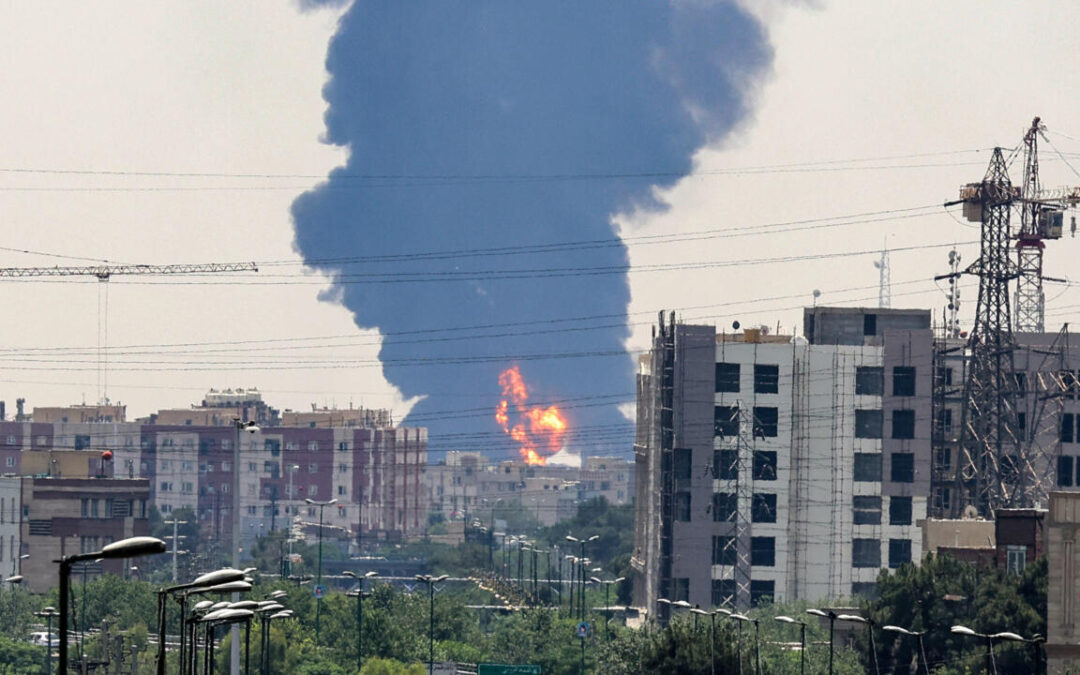The Iran-Israel conflict is, in many ways, a stark reminder of the insurance industry’s evolving role as an absorber of geopolitical and systemic risk in an increasingly interconnected world, says Morningstar DBRS, a global credit rating agency
The hostilities between Iran and Israel, which appear to be continuing despite reports of a ceasefire, present a complex set of financial, operational, and strategic risks for insurers, says Morningstar DBRS, a global credit rating agency.
The ripple effects extend well beyond the immediate combat zone, affecting marine shipping lanes, aviation corridors, cyber networks, global capital markets, and supply chains.
The Iran-Israel conflict is, in many ways, a stark reminder of the insurance industry’s evolving role as an absorber of geopolitical and systemic risk in an increasingly interconnected world.
The geopolitical consequences of a prolonged Iran-Israel conflict could be far reaching. The Strait of Hormuz, a global oil and liquefied natural gas (LNG) shipping artery, remains vulnerable to disruption.
Iran’s demonstrated willingness to engage in asymmetric warfare, including attacks on
shipping vessels and global cyber networks, adds complexity to risk assessments.
Meanwhile, regional tensions are drawing in global powers, increasing the potential for wider geopolitical shocks.

Marcos Alvarez, Managing Director, Global Financial Institution Ratings.
The Iran-Israel conflict represents a multifaceted challenge for the global insurance industry, touching nearly every property and casualty business line and asset class”, said Marcos Alvarez, Managing Director, Global Financial Institution Ratings.
“From a credit perspective, the conflict increases downside risk for insurers with high exposure to specialty marine, aviation, cyber, and political risk portfolios. Balance sheet resilience, underwriting discipline, and proactive capital management will be critical differentiators for insurers navigating this environment,” he said.
A Broad-Base Challenge for Insurers
The Iran-Israel conflict represents a multifaceted challenge for the global insurance industry, touching nearly every property and casualty (P&C) business line and asset class.
While higher premiums in marine and aviation may offer some short-term underwriting relief, the accumulation of risk exposures across war, cyber, travel, and political risk lines presents meaningful capital pressure for many insurers.
Simultaneously, investment portfolio volatility can threaten capital buffers and solvency margins.
From a credit perspective, the conflict increases downside risk for insurers with high exposure to specialty marine, aviation, cyber, and political risk portfolios. Balance sheet resilience, underwriting discipline, and proactive capital management will be critical differentiators for insurers navigating this environment, particularly if the conflict is prolonged.
Companies with strong reinsurance protection, conservative investment allocations, and proactive enterprise risk management frameworks are better positioned to weather the volatility.
Conversely, insurers with aggressive growth strategies in high-risk lines, limited capital flexibility, or high equity markets exposure may face pressure on credit rating outlooks if the conflict escalates further.
Marine Insurance: Surging War-Risk Premiums and Concentration of Exposures
Marine insurance is often the first line of insurance business to react in a geopolitical crisis, and the current situation is no exception.
Beyond Israeli ports, the broader Middle Eastern region has seen significant risk repricing. Ships transiting the Red Sea, the Strait of Hormuz, and the Persian
Gulf, which are all critical global energy trade chokepoints, are facing rapidly rising premiums.
Indeed, according to the Financial Times, hull (physical damage) and machinery insurance premiums for ships passing through the Strait of Hormuz jumped 60% in the last few weeks.
The rapid escalation in war-risk premiums is a double-edged sword for marine insurers. Higher pricing may bolster underwriting profitability in the short term, particularly for specialty marine underwriters providing war coverage.
However, the concentration of risk in key shipping lanes raises the potential for significant, correlated losses if a major incident occurs. The seizure or targeting of commercial tankers by Iranian forces in the past demonstrates how quickly insured
losses can materialize.
For instance, a direct missile strike on a large LNG tanker could result in insured losses exceeding $500 million considering hull, cargo, and potential liability claims.
Moreover, insurers with significant war-risk portfolios may face rising reinsurance costs or reduced capacity from global reinsurers, many of which are already cautious following years of significant natural catastrophe losses.
The war-risk accumulation problem could thus strain capital adequacy ratios for some specialty underwriters and marine syndicates.
Aviation Insurance: Exposure to Airspace Conflict and Ground Risks
The Iran-Israel conflict also increases risks for the aviation sector, where insurers cover hull and liability exposures. Middle Eastern airspace has become increasingly hazardous, with commercial airlines rerouting flights to avoid Iranian, Iraqi, and Israeli airspace.
For insurers, this translates into elevated exposure to hull war risks. Although war-risk policies often contain exclusionary clauses that limit coverage in active conflict zones, the nature of modern missile and drone technology makes it difficult to fully anticipate or contain losses.
A stray missile or miscalculated air defence response could result in the loss of commercial aircraft, triggering significant insurance claims.
For instance, Iranian air defences shot down a Ukraine International Airlines Boeing 737-800 in January 2020 with 176 occupants minutes after takeoff from Tehran when it was mistakenly identified as an American cruise missile.
In addition to in-flight risks, airports, maintenance facilities, and aviation infrastructure in Israel, Jordan, and Gulf states are now under heightened threat.
Ground-based attacks could lead to property damage, business interruption, and liability claims. War-risk underwriters have already begun to reprice premiums and tighten policy wordings, introducing more explicit exclusions for conflict zones.
The aviation sector poses a material risk to insurers with significant exposure to commercial aviation hull and liability lines. While global insurers have reduced their overall aviation war-risk exposure since the grounding of aircraft in Russia following the invasion of Ukraine, any large aviation loss event could still strain balance sheets. Reinsurers may also impose higher attachment points or reduce retrocession capacity, forcing primary carriers to absorb higher loss retentions.
Cyber Insurance: The Rising Threat of State-Sponsored Attacks
Cyber is likely the most strategically significant insurance line affected by the Iran-Israel conflict. Based on media reports, the conflict has already involved significant state-sponsored cyber activity on both sides. Israeli authorities have accused Iranian-linked groups of orchestrating cyberattacks targeting critical infrastructure while Iran has accused Israel of launching sophisticated cybersabotage operations, including one aiming to disrupt the country’s payment system.
Unlike conventional military activity, cyber warfare crosses borders instantaneously and can affect insureds far from the physical conflict zone. Insurance companies are also potential targets, as demonstrated by recent cyberattacks against several U.S. regional insurers and reinsurers without a direct connection to Middle East operations.
For cyber insurers, the growing scale and sophistication of state-sponsored cyberattacks have been raising questions about risk modelling, underwriting, and capital adequacy. Many policies contain “war exclusions” that seek to reduce or eliminate claims caused by nation-state cyber warfare, but legal disputes over attribution are increasingly common. Courts may be reluctant to accept narrow interpretations of war exclusions in the face of ambiguous cyberattack attribution. Cyber underwriters could face higher reinsurance costs, more selective capacity allocation, and tougher pricing negotiations.
The loss of confidence in cyber risk models, particularly for accumulation events driven by systemic attacks, poses a potential capital risk for insurers heavily exposed to the
cyber market.
Broader Property, Political, and Supply Chain Risks
Beyond these core lines, the Iran-Israel conflict raises significant concerns across other P&C business segments. Commercial property insurers face increased political risk exposure for multinational corporations with operations in the region.
Energy companies, logistics providers, and exporters operating in or near conflict zones may seek additional political risk insurance or terrorism coverage, which is becoming increasingly expensive.
Trade credit insurers may also face rising claims as exporters struggle to fulfil contracts because of shipping disruptions or sanctions. The risk of retaliatory sanctions and financial system instability could heighten exposures for insurers active in global trade credit and political risk markets.
Additionally, global supply chain disruptions could trigger claims under contingent business interruption coverages, especially if maritime chokepoints are blocked. The interconnected nature of modern supply chains means that localized conflict events can have cascading effects on insured losses across multiple regions and industries.
Capital Markets Volatility and Investment Portfolio Risks
Beyond underwriting exposures, insurers face significant balance sheet volatility from the broader financial market’s response to the conflict. Equity markets have already seen heightened volatility, with risk-off sentiment prompting capital flows into safe-haven assets such as gold.
For insurers, investment portfolio stability is a key component of credit quality. In particular, life insurers rely on stable investment returns to support long-term policyholder obligations.
Sharp declines in equity markets can erode capital surplus while widening corporate bond spreads may lead to mark-to-market losses on fixed income portfolios. Emerging market debt and equities—favoured by some insurers for yield enhancement—may come under pressure if the conflict intensifies or if global economic sentiment further deteriorates.
A protracted conflict scenario may force insurers to reallocate portfolios toward higher-quality, shorter-duration assets to preserve capital adequacy ratios. However, such defensive repositioning could further compress investment income, especially in a global environment with yields trending lower.
Solvency regimes, such as Solvency II in Europe and Risk-Based Capital in the U.S., may
impose higher capital charges on insurers experiencing material asset impairments or credit migrations.
Liquidity strain could also emerge if policyholders withdraw funds or insurers are
forced to realize losses to meet claim payments. However, in our view, this scenario remains remote for now.

